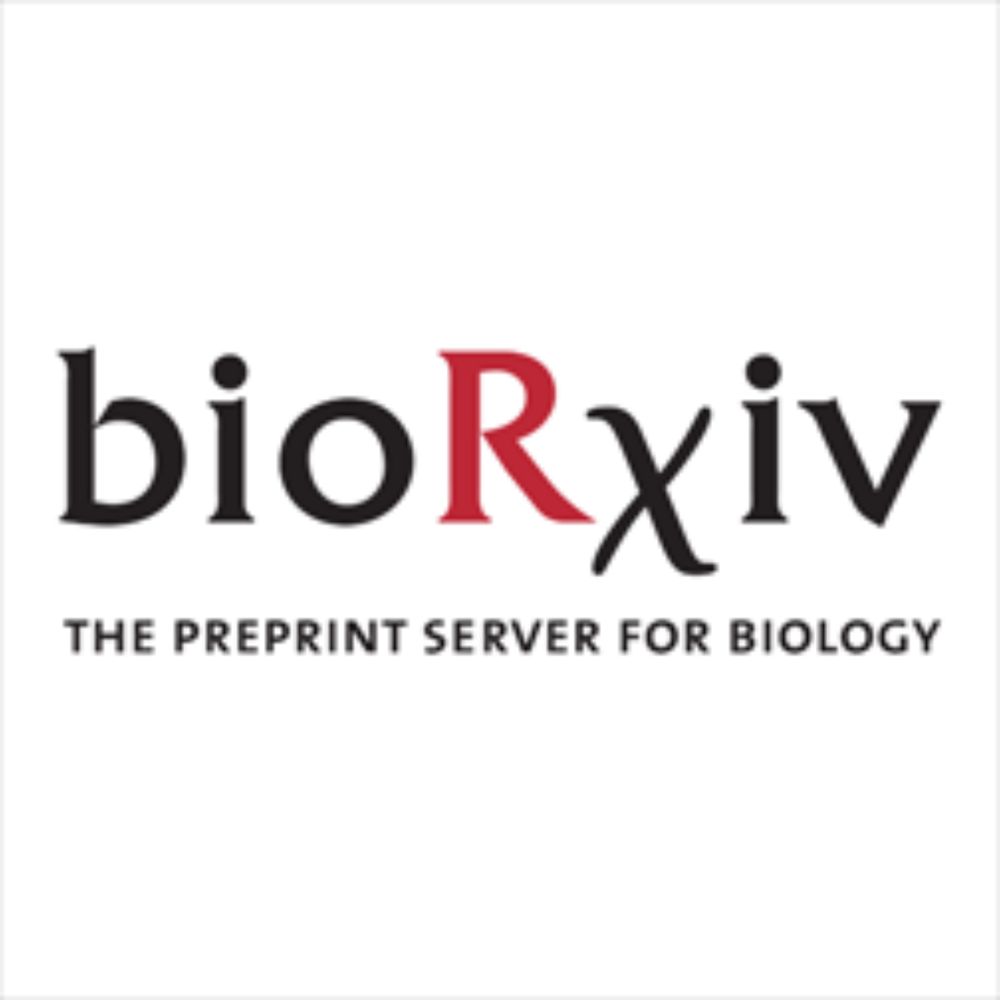Special thanks to our amazing collaborators:
Nathanson Lab, Prins Lab, UCLA Neurosurgery, as well as the members of the Bhaduri Lab who have provided advice, edits, and moral support throughout. We look forward to hearing what the community thinks!
24.06.2025 02:24 — 👍 2 🔁 0 💬 0 📌 0
💡iHOTT is a human, patient-specific, matched platform to study tumor–immune interactions. It recapitulates key features of tumor-immune interactions, offering a new tool for immunotherapy discovery.
📄Paper: biorxiv.org/content/10.1...
🌍Data: cells.ucsc.edu?ds=ihott
24.06.2025 02:24 — 👍 1 🔁 0 💬 1 📌 0
🔗Were there shared antigens across patients? We used GLIPH2 to find out. The short answer: not really. Most T cell clonotypes were private to an individual tumor. This tells us something important: GBM’s immune landscape is highly personalized *and* iHOTT robustly captures that.
24.06.2025 02:24 — 👍 1 🔁 0 💬 1 📌 0
To understand the T cell response, we performed TCR sequencing on treated samples. Clonal diversity increased & new clones emerged 🌈. These novel clones were driven by CD4 T-cells and expressed TCF7, a marker for stem-like T cells that has been linked to improved outcomes.
24.06.2025 02:24 — 👍 1 🔁 0 💬 1 📌 0

But MOST interestingly ⭐, when we benchmarked iHOTT against patients treated with pembrolizumab as part of a clinical trial, we noted the *exact same* cell type shifts, validating that iHOTT recapitulates patient biology. This was an exciting finding ‼️
24.06.2025 02:24 — 👍 1 🔁 0 💬 1 📌 0
We treated iHOTT with pembrolizumab 💊to understand the effects of immunotherapy. Interestingly, we noted expansion of CD4+ T cells and B cells and enrichment pathways reflecting immune activation. The cytokine profile also changed with increases in IL15, IL25, and IL17F.
24.06.2025 02:24 — 👍 1 🔁 0 💬 1 📌 0

Our model preserved immune and tumor cell types after co-culture. We also saw immune activation and upregulation of GBM-linked cytokines like IL-6, IL-8, IL-10, and G-CSF, notably seen *only* when tumor cells and PBMCs were cultured together.
24.06.2025 02:24 — 👍 1 🔁 0 💬 1 📌 0

Most GBM models miss one of two things:
🛡️ a functional immune system
🧠 a human brain microenvironment
iHOTT has both.
🧫 We co-culture freshly isolated patient tumor cells + matched PBMCs on human cortical organoids. It’s patient-specific, matched, and immunocompetent.
24.06.2025 02:24 — 👍 1 🔁 0 💬 1 📌 0
🧵Excited to share our new preprint introducing iHOTT - an autologous tumor-immune co-culture model that captures patient-specific responses in #Glioblastoma
💥Now on
@biorxivpreprint
: biorxiv.org/content/10.1...
Led by Dr. Shivani Baisiwala, Neurosurgery Resident in the lab
24.06.2025 02:24 — 👍 6 🔁 4 💬 1 📌 0
A huge thank you to the amazing collaborators and members of the Bhaduri Lab for their contributions to this study! Antoni Martija, @prnano9, @Jalbsoto, Dan Jaklic, @MilJessenya, Rista White, @JacquiMMartn1, Dakshesh Rana, @GeschwindLab
06.05.2025 16:50 — 👍 2 🔁 0 💬 0 📌 0
Taken together, our findings suggest that the early entry of thalamocortical afferents in human and nonhuman primate cortex mediates communication with cortical progenitors. This demonstrates that the human thalamus actively sculpts cortical architecture during early development! 🧩
06.05.2025 16:50 — 👍 1 🔁 0 💬 1 📌 0
Leveraging the tractability of the organoid model, we knocked out thalamic NRXN1 to show that when disrupted, thalamic axons fail to form stable contacts with cortical outer radial glia, leading to impaired upper layer neurogenesis.
06.05.2025 16:50 — 👍 0 🔁 0 💬 1 📌 0
Our key player: NRXN1, a cell adhesion molecule expressed by thalamic neurons, which directly contacts outer radial glia. 🤝 We identify NRXN1-NLGN1 gene expression and protein colocalization along thalamocortical afferents and outer radial glia in the assembloid and human primary cortical tissue.
06.05.2025 16:50 — 👍 1 🔁 0 💬 1 📌 0
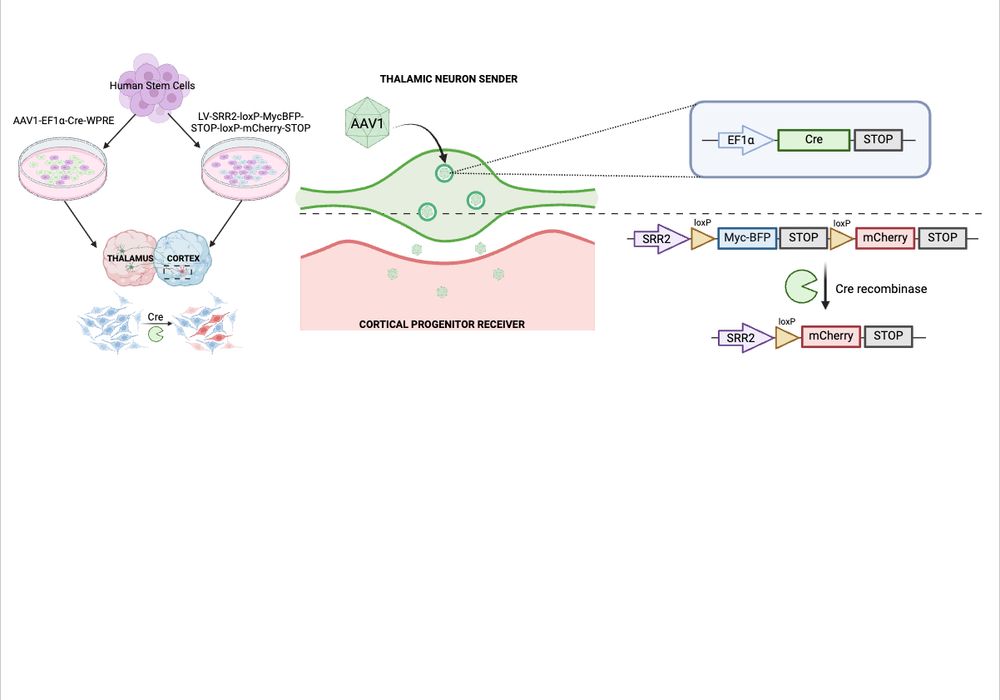
Cre-dependent anterograde tracing demonstrates that thalamocortical axons make physical connections with cortical outer radial glia - a primate-enriched progenitor cell type central to cortical expansion. 🧠 But what types of cell-cell interactions mediate this contact?
06.05.2025 16:50 — 👍 1 🔁 0 💬 1 📌 0
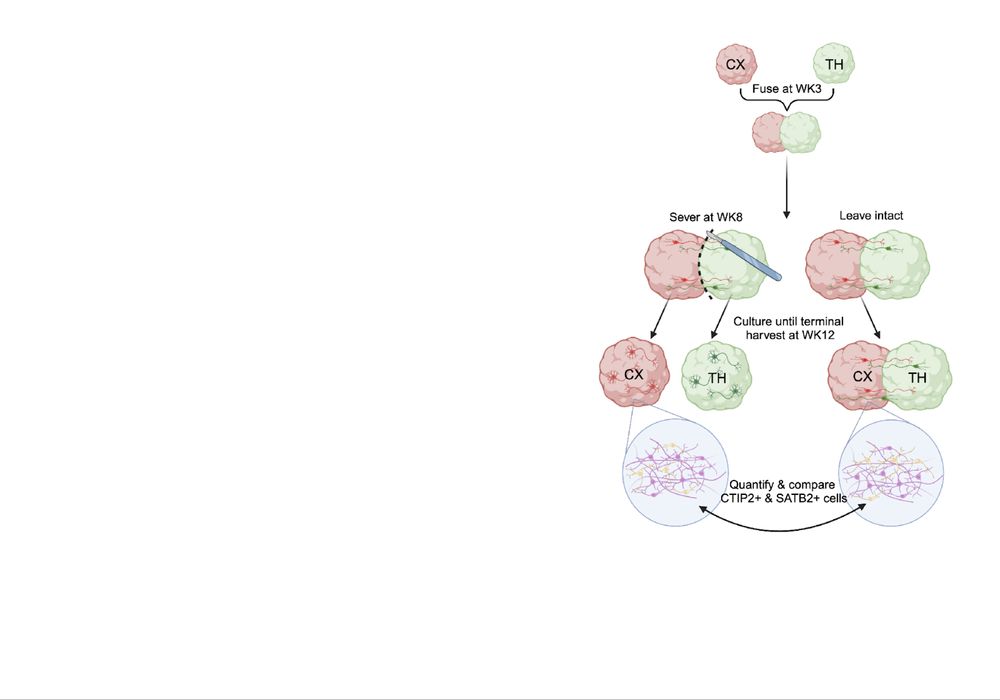
Interestingly, severance ✂️ of the thalamic input midway through neurogenesis actually maintains these increased upper layer neurons. But how is early thalamic input changing the future fate of cortical cell types? Our work indicates communication with progenitors may be the answer…
06.05.2025 16:50 — 👍 1 🔁 0 💬 1 📌 0


Utilizing the human thalamocortical assembloid model, we show that thalamic input increases the generation of upper layer cortical neurons compared to cortex-only controls. 🧫 This work shows extrinsic cues like thalamic input can shape intrinsic cortical programs.
06.05.2025 16:50 — 👍 1 🔁 0 💬 1 📌 0
Excited to present our new preprint led by @claudianguyen95 uncovering how thalamic input shapes human cortical development! We discover that thalamic axons promote the generation of upper layer cortical neurons through NRXN1-mediated contacts with outer radial glia. www.biorxiv.org/content/10.1...
06.05.2025 16:50 — 👍 5 🔁 2 💬 1 📌 0
Congratulations @prnano9.bsky.social!!! We are thrilled that this paper is out and hope everyone enjoys using the datasets and meta-atlas tools!!
02.05.2025 01:03 — 👍 10 🔁 0 💬 0 📌 0
We hope this dataset including metabolomics and scRNA-seq data will be useful to others who are interested in metabolism and cortical cell fates! Shoutout to @madelineandrews.bsky.social and all of our collaborators and the @uclastemcell.bsky.social for contributions and input on this project.
13.03.2025 04:36 — 👍 6 🔁 0 💬 2 📌 0

This led us to a model that indicates that glycolysis, through PPP, seems to restrict radial glia from generating oRGs, astrocytes, and inhibitory neurons too early in development. This may be why inhibition of glycolysis and PPP led to an increase of these cell types.
13.03.2025 04:36 — 👍 1 🔁 0 💬 1 📌 0

To test if PPP was guiding radial glia cell fate, we (painfully) extracted EGFP labeled radial from organoids and knocked down PPP genes. Indeed, same story. More oRGs, astrocytes, and inhibitory neurons paired with a decrease in PPP metabolite abundance.
13.03.2025 04:36 — 👍 0 🔁 0 💬 1 📌 0
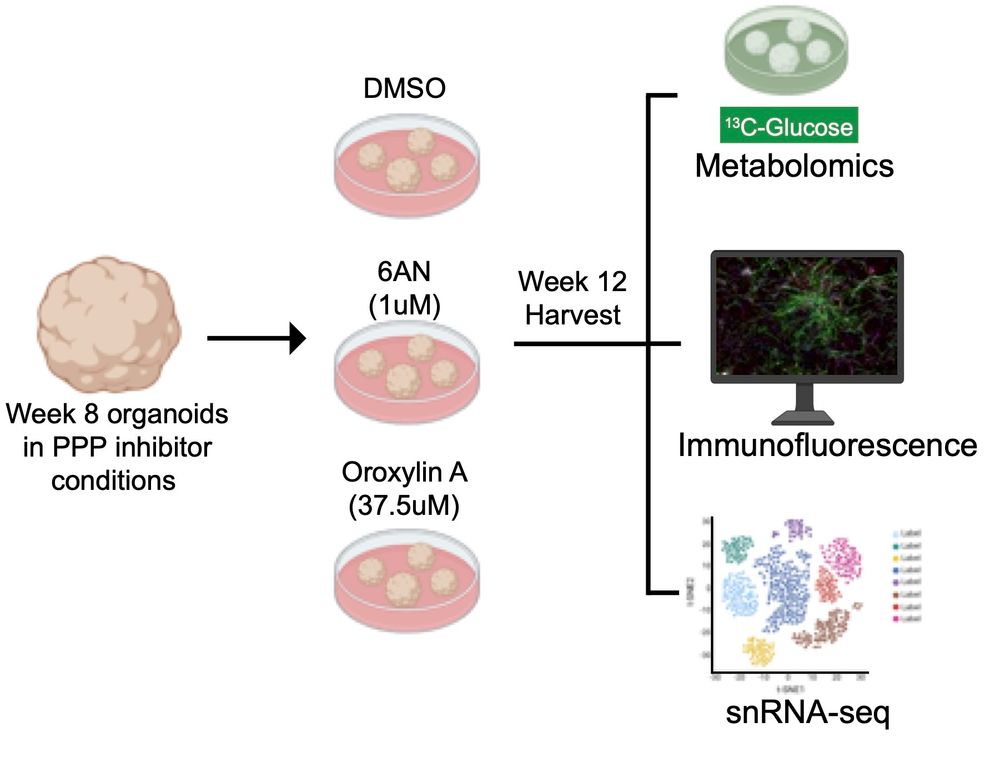
This was fascinating because PPP also peaks in primary tissue at the same time as glycolysis. Was glycolysis working through the PPP? We tested this by inhibiting PPP with pharmacological inhibition, and also saw an increase in oRGs, astrocytes, and inhibitory neurons.
13.03.2025 04:36 — 👍 1 🔁 0 💬 1 📌 0
Organoids love sugar! Using staining and scRNA-seq, we saw an increase in outer radial glia (oRGs), astrocytes, and inhibitory neurons. When we examined metabolite abundance in this experiment many pathways, including the pentose phosphate pathway (PPP) were downregulated.
13.03.2025 04:36 — 👍 0 🔁 0 💬 1 📌 0
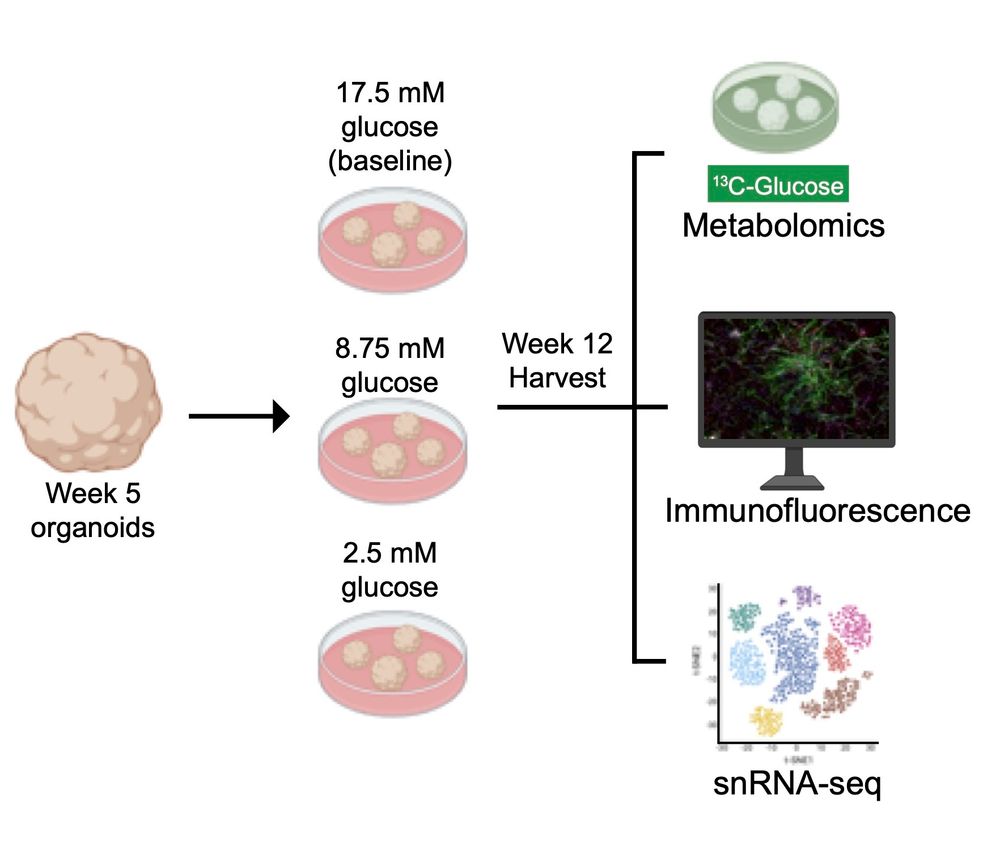
This was intriguing because glycolysis has been a flash point and somewhat controversial in organoids. Is it up in organoids? And if so, does it impact cell fate? We tested this by lowering glucose levels in organoid culture and measuring how cell types changed.
13.03.2025 04:36 — 👍 0 🔁 0 💬 1 📌 0
We saw known changes in metabolites, and discovered many novel dynamics. When comparing organoids to primary tissue, we saw that many metabolites were preserved (80%) but some had opposite trends over development. Some of these were in downstream parts of glycolysis…
13.03.2025 04:36 — 👍 4 🔁 0 💬 1 📌 0
We used both primary tissue and organoids to look at metabolism, observing interesting glycolysis dynamics in primary tissue during peak neurogenesis. Shoutout to the @ChristofkLab for their close collaboration and generation of the metabolomics data!
13.03.2025 04:36 — 👍 0 🔁 0 💬 1 📌 0
Postdoctoral Scholar – Laboratory of Dr. William Zeiger – UCLA Brain Research Institute (BRI)
It’s good to be in California these days. Come join us! We’ve got an open post-doc position funded by CA institute for regenerative medicine. It’s a big multi-disciplinary team science project led by @bhadurilab.bsky.social. Organoid transplants, neuro development, 2P! bri.ucla.edu/open-positio...
05.02.2025 00:37 — 👍 3 🔁 2 💬 0 📌 0
Thank you to the @uclastemcell.bsky.social for their unwavering support and for this piece on our lab!
05.02.2025 20:13 — 👍 6 🔁 0 💬 0 📌 0
Very cool - congrats! Excited to read the whole thing shortly!!
03.02.2025 21:29 — 👍 1 🔁 0 💬 0 📌 0
PhD candidate | AHA Predoc Fellow | Grad student rep at Flyboard | Studying brain metabolism and development in the Tennessen Lab at IU Bloomington | She is into dancing and Drosophila 💃🏽🎶🎙️👩🏽🔬🔬
Associate Professor @ScrippsResearch. Building neurotech to study how genes and physiology impact brain function 🧬 🧠 jin.scripps.edu
Bioscientist. Associate Professor at Rice University. Editor-in-Chief, Differentiation. Neural crest, zebrafish, enteric nervous system and peripheral nervous system development
Neuroscience, meninges, blood-brain barrier, cake (or cookies)
http://siegenthalerlabcu.weebly.com/
Asst. Prof UCLA | Glial biologist interested in how glial-neuron interactions shape neuron health and function throughout the lifespan. Mother and wife. Lover of nature, novels, and really good bread. | Opinions my own.
Postdoc @bhadurilab.bsky.social
Human brain development + single-cell omics
👩🏻🔬 Simplifying public health with data-driven insights
💡 Helping you make informed health decisions
🎓 MPH, PhD
👇🏻 Get weekly science-backed updates
https://yourlocalepidemiologist.substack.com/
Pharmacist turned Developmental Neurobiologist, Ph.D. Candidate @ BSBE Department, IIT Kanpur, India 🇮🇳 https://x.com/agnihotrinitin
Group leader
@sangerinstitute.bsky.social Neural diversity, spatial transcriptomics, glia, GBM
Developmental Neurobiology | Autism | Epilepsy | Cortex | Neural stem cells | mouse | human
Assistant Professor Weill Cornell Medicine.
UCLA, University of Sheffield, University of Newcastle upon Tyne alum
capearsonlab.com
(Posts my own opinions)
Biologist by profession, botanist by training, historian by heart. Researching 3D tissue morphogenesis from embryos to organoids
@TIFRscience @mpicbg @ETH @bsse
byakankshajain.blogspot.com
The Institute for Human Genetics (IHG) is the hub for genetics/genomics research, technologies, industry partnerships, training, and education at UCSF.
Join us as we discuss the latest stem cell research, policy, and news with field experts. Brought to you by @stemcell.com.
🔗 stemcellpodcast.com
Genetics and development of the cerebral cortex
@ipnp.bsky.social
@institutimagine.bsky.social
Posts are from lab members (not Alessandra herself)
Cancer scientist and oncologist, Professor at Stanford and Director of the Stanford Cancer Institute
Department of Neurological Surgery @ucsanfrancisco.bsky.social. We focus on providing the best possible care for our patients, alongside research efforts to develop better treatments.
neurosurgery.ucsf.edu











